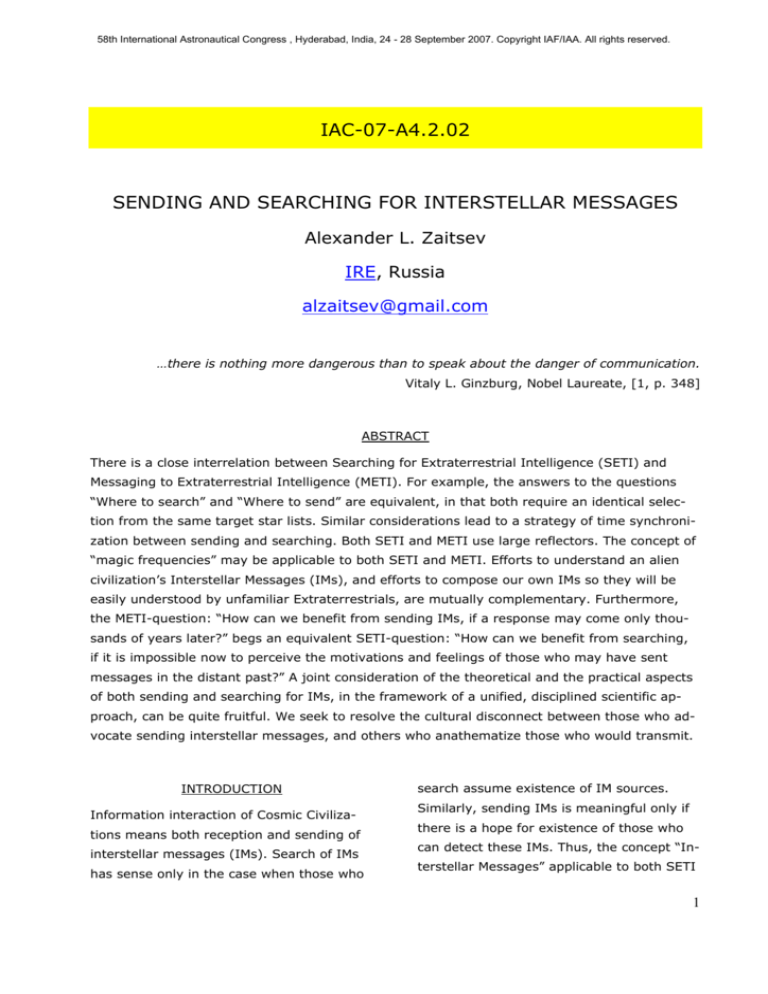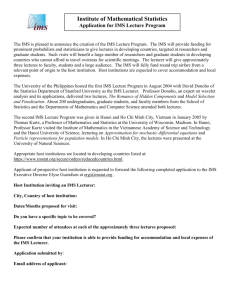
58th International Astronautical Congress , Hyderabad, India, 24 - 28 September 2007. Copyright IAF/IAA. All rights reserved.
IAC-07-A4.2.02
SENDING AND SEARCHING FOR INTERSTELLAR MESSAGES
Alexander L. Zaitsev
IRE, Russia
alzaitsev@gmail.com
…there is nothing more dangerous than to speak about the danger of communication.
Vitaly L. Ginzburg, Nobel Laureate, [1, p. 348]
ABSTRACT
There is a close interrelation between Searching for Extraterrestrial Intelligence (SETI) and
Messaging to Extraterrestrial Intelligence (METI). For example, the answers to the questions
“Where to search” and “Where to send” are equivalent, in that both require an identical selection from the same target star lists. Similar considerations lead to a strategy of time synchronization between sending and searching. Both SETI and METI use large reflectors. The concept of
“magic frequencies” may be applicable to both SETI and METI. Efforts to understand an alien
civilization’s Interstellar Messages (IMs), and efforts to compose our own IMs so they will be
easily understood by unfamiliar Extraterrestrials, are mutually complementary. Furthermore,
the METI-question: “How can we benefit from sending IMs, if a response may come only thousands of years later?” begs an equivalent SETI-question: “How can we benefit from searching,
if it is impossible now to perceive the motivations and feelings of those who may have sent
messages in the distant past?” A joint consideration of the theoretical and the practical aspects
of both sending and searching for IMs, in the framework of a unified, disciplined scientific approach, can be quite fruitful. We seek to resolve the cultural disconnect between those who advocate sending interstellar messages, and others who anathematize those who would transmit.
INTRODUCTION
Information interaction of Cosmic Civilizations means both reception and sending of
interstellar messages (IMs). Search of IMs
has sense only in the case when those who
search assume existence of IM sources.
Similarly, sending IMs is meaningful only if
there is a hope for existence of those who
can detect these IMs. Thus, the concept “Interstellar Messages” applicable to both SETI
1
(treated as searches of IMs) and METI
undertake at the detection of IMs” (“Model
(treated as sending of IMs).
of the Cosmic Civilization conducting
The given concept can be considered as a
specific invariant of transformation SETI Ù
METI. As such an approach there is no divi-
searches of IMs”). Altogether, we come to
four aspects of the problem of sending and
searching for IMs.
sion into Terrestrial and Extra-Terrestrials
Below the concept of four aspects is ex-
and opposition of the Earth and Cosmos
plained using the above-mentioned ap-
that allows considering attempts of informa-
proach to SETI and METI [2], but formu-
tion interaction of intelligence space sys-
lated from the uniform position of sending
tems as something universal, inherent to
and searching for IMs and in terms of the
the inhabited Universe. Besides, it is impor-
information interaction of Cosmic Civiliza-
tant to note that at such an approach one
tions:
does not talk any longer about “Messages
from the Earth” but about Interstellar Messages. This may lower the tension in the
discussions with those who feel superstitious fear and anxiety as soon as sending
and transmissions are mentioned.
1. In what is the sense of sending and
searching for interstellar messages?
2. Where to send and where to search for
IMs?
3. The dangers related to sending and
searching for IMs.
At the searches, two aspects are analyzed.
First (1), how to answer such questions related to Searches of IMs as "Where to
search?", “Whether there is a sense to
search?", “Whether searches are danger-
WHAT IS THE MAIN IDEA BEHIND SENDING
AND SEARCHING FOR INTERSTELLAR
MESSAGES?
ous?”, etc., based on the current science
It is considered, that the main idea of
about the nature and a society and techno-
searches is obvious and trivial; it consists in
logical level. Second (2), how the Sender
an opportunity to receive valuable informa-
acted from the point of view of conducting
tion. But it is not as simple as seems.
searches and what purposes it pursued
Really, how can we benefit from searching,
sending IMs ("Model of the Cosmic Civiliza-
if it is impossible now to perceive the moti-
tion who sends IMs"). Two similar aspects
vations and feelings of those who may have
can be analyzed at sending: (3) how to an-
sent IMs in the distant past? What for to
swer such questions of IM Sending as:
send IMs? And whether there is basically
“Where to send?”, “Whether there is a
such need, as sending IMs? If we declare
sense to send?”, “Whether sending is dan-
that we can explain our reasons for
gerous?”, etc., based on the current state of
searches and we can prove the need of
science about the nature and society, and
sending signals, then the search gets mean-
technological level, and (4) how the ad-
ing as proved by the existence of the sub-
dressee will act from the point of view of
ject of the search. It has been already noted
conducting sending and what actions it will
repeatedly [see, e.g. 3] that sending and
2
searches are in close indissoluble interrela-
candidate for sending IMs? Or, is there a
tions. Only after we understand (or, on the
hope (and if yes, what it is based on) that
contrary, after we have not managed to un-
Others will choose the Sun as the addressee
derstand) what for we need sending IMs
of IMs and will put our star on the target-
and if such an unselfish and messianic ac-
list? Similarly regarding sending IMs: are we
tivity is natural for a developed civilization,
objects of search for those whom we choose
we can prove the searches themselves as
as addressees of own sending? May our ef-
well as that SETI is meaningful (or, on the
forts be worthless since from Their point of
contrary, it is not meaningful). Also, after
view, our Sun does not represent absolutely
we understand what is the need for Intellect
any interest as the object of search? And so
to send information to prospective Others,
on…
we naturally come to understanding the
sense of our own transmissions. So far a
question: “Is sending IMs some indispensa-
THE DANGER RELATED TO SENDING AND
ble attribute of Intellect?” is not answered.
SEARCHING FOR INTERSTELLAR MESSAGES
And, hence, it is not answered the question:
Quite often one can hear cautions to those
“Does SETI have sense?”
who under own initiative, without a sanction
Sure, we leave aside two such exotic explanations, as: (1) "Sense of SETI consists in
searches not purposeful transmissions, but
leakage of electromagnetic radiation" and
(2) “Sense of sending is a kind of “fishing”
by aggressive super-civilizations of trustful
and ingenuous, naive and unripe civilizations such as the terrestrial one.” If we accept them, then SETI will get a simple role
of a tool to search for such potential "Star
Aggressors" and "Star Interventionists" and
with the unique purpose to find them and
hide without any response to them.
of the United Nations or a similar international organization, sends IMs. The argument of opponents of sending initiative IMs
is well-known, it can be found, for example,
in [5] and there is no need here once again
to repeat it. However, to be consistent, it is
necessary to agree that uncontrolled
searches are also unsafe. If a country receives a certain “premature knowledge” as a
result of a search not controlled by the
United Nations or a similar international organization and this country is not ready
from the moral-ethical point of view, this
country (or a coalition of the countries) may
use it to harm the rest of the mankind.
WHERE TO SEND AND WHERE TO SEARCH
FOR INTERSTELLAR MESSAGES?
In addition to traditional criteria of target
star selection [4] for both SETI and METI,
there is a number of additional questions
under joint “Sending & Searching” consideration. For example, does our star fits as a
Imagine that some morally ugly creature or
a religious fanatic with the ideas on the
level of the Stone Age suddenly receives the
secrets of a terrible and powerful weapon!
Thus, it is necessary to keep SETI under
some effective international control. In
other words, in case of using the concept
3
“Sending and searching for IMs”, the shift
much greater than the size of stars and
from a specific question “Is METI danger-
“belts of a life” around the stars. Therefore
ous?” to more general question “Is such
at pointless casual radiation transmission
human activity as sending and searching for
the probability of getting into inhabited
intelligence signals in the Universe danger-
zones is insignificantly small. It is important
ous in principle?” is quite reasonable.
to mention the following feature of the radar
As to the danger related to transmission of
interstellar radio messages (IRMs), a more
careful analysis shows that the pointed radiation of IRMs sent using planetary and asteroid radar telescopes, apparently, is not
as dangerous as pointless transmissions of
the same radars. Fig. 1 indicates all transmissions during radar observations of planets, asteroids and comets. Data on radar
observations of asteroids and comets, carried out by the radars located in Arecibo
(347 red points), Goldstone (661 blue
points), and Evpatoria (215 green points),
are taken from [6], and on a radar observations of planets (unfortunately, only for
Goldstone and Evpatoria) – from [7, 8].
observations of Solar system bodies: a slow
scanning over the celestial sphere that is
related to the proper motion of targets of
the radar observation. From this fact two
important conclusions follow. First, this may
explain why we do not detect any radar signals from other civilizations. Ostro and Sagan [10] explained the absence of signals
from Their radar telescopes by the idea that
They may not use a radar astronomy and,
consequently, are not protected against the
asteroid or comet hazard. We have another,
rather reasonable explanation. If the probability of our radar transmissions to get into
the habitable zones of cataloged stars is
very low and They do not see us, then the
probability to get to the Earth at similar
pointless transmissions implemented by
other civilizations is also very low. For this
reason, we also do not see Them.
The second, not less essential conclusion
from that fact that any of our 1223 transmissions have not get into a habitable zone
of the Type I civilizations (the civilizations of
the type higher than the first one live "practically everywhere", not just near the parent
stars, [11]) when the radar beams slowly
scan the sky, illuminating greater areas of
The analysis of radar data has revealed the
the Galaxy, consists that such radiation is
following experimental fact: any among the
much easier to be detected by those un-
1223 transmissions does not get to stars
known aggressive and super-power civiliza-
[9]. This means that the interstellar space is
tions which scare so much the METI-
almost empty; the distance between stars is
opponents. In this sense rare pointing
4
transmissions of interstellar radio messages
However, it is clear that a ban on radar in-
represent considerably smaller danger than
vestigations of small solar-system bodies
numerous addressless radar astronomy
makes it impossible to provide a protection
transmissions. There are two reasons for
against asteroid and comet hazard [12].
that. First, IRMs are precisely directed to
Moreover, we can see a rapid growth in the
target specific stars, and, second, the radar
number of new radar detections of asteroids
beam is motionless relatively to other stars
and comets [13], Fig. 3, and this tendency
and, hence, during radiation does not pro-
will grove even stronger when more power-
vide any scanning and does not illuminate
ful and dedicated asteroid and comet radar
gradually celestial sphere (Fig. 2).
systems will be created, [14]. This will result in more complete coverage of the celestial sphere by terrestrial power electromagnetic radiation.
Thus, in order to be detected by some
young Type I civilizations living nearby the
parent stars, it is necessary to address our
IRM transmissions. Accidental detection by
Thus, the notorious thesis that it is pointed
such civilizations of signals from the plane-
radiations of IRMs that represent the fatal
tary and asteroid radars of some Other civi-
“danger” should be ruled out from the
lization is extremely unlikely. If we are
agenda. Therefore, we guess that it is quite
afraid of powerful and aggressive civiliza-
reasonable now to try to use Arecibo Radar
tions of Type II and Type III, which live
Telescope and Goldstone Solar System Ra-
"practically everywhere", it is necessary to
dar, along with the Evpatoria Planetary Ra-
forbid numerous pointless transmissions of
dar, which was already used for Cosmic Call
asteroid and planetary radars as their radia-
1999 & 2003 and Teen Age Message 2001
tion gradually illuminates greater areas that
transmissions [15], as interstellar radio
promotes its detection by "star aggressors
message transmitters. These radars have a
and interventionists".
few times greater energy potential than the
Evpatoria one [16], so they can provide
more efficient sending of further IRMs.
5
Acknowledgments. I thank Allen Tough for
I am grateful to Ludmilla Kolokolova for her
valuable remarks and financial support.
useful comments on the manuscript.
REFERENCES
1. Communication with Extraterrestrial Intelligence (CETI), by Carl Sagan (Editor). Cambridge
& London: The M.I.T. Press, 1973.
2. A. Zaitsev. Messaging to Extra-Terrestrial Intelligence, http://arxiv.org/abs/physics/0610031
3. A. Zaitsev. The SETI Paradox, http://arxiv.org/abs/physics/0611283
4. M. Turnbull and J. Tarter. Target Selection for SETI: 1. A Catalog of Nearby Habitable Stellar
Systems, http://arxiv.org/abs/astro-ph/0210675
5. D. Brin. Shall We Shout Into the Cosmos? http://www.davidbrin.com/setisearch.html
6. JPL Solar System Dynamics, http://ssd.jpl.nasa.gov/?radar
7. Planetary Ephemeris Data, http://iau-comm4.jpl.nasa.gov/plan-eph-data/index.html#radar
8. Russian Radar Ranging of Planets (1962-1995),
http://www.ipa.nw.ru/PAGE/DEPFUND/LEA/ENG/rrr.html
9. D. Churakov. E-mail communication on June 28, 2007.
10. S. Ostro and C. Sagan. Cosmic Collisions and Galactic Civilizations. Astronomy & Geophysics: The Journal of the Royal Astronomical Society, 39 (4), 1998, 22-24. See also: http://trsnew.jpl.nasa.gov/dspace/bitstream/2014/19498/1/98-0908.pdf
11. Kardashev civilizations, http://www.daviddarling.info/encyclopedia/K/Kardashevciv.html
12. Near-Earth Object Survey and Deflection Analysis of Alternatives, NASA Report to Congress,
March 2007, http://www.nasa.gov/pdf/171331main_NEO_report_march07.pdf
13. Asteroid Radar History, http://echo.jpl.nasa.gov/asteroids/PDS.asteroid.radar.history.html
14. S. Ostro, A. Zaitsev, Y. Koyama, and A. Harris. Dedicated Asteroid and Comet Radar. XXIIIrd IAU GA Abstract Book, 1997, Kyoto, Japan, 50, http://fire.relarn.ru/126/docs/iau23kyoto.pdf
15. Interstellar Radio Message (IRM), http://www.daviddarling.info/encyclopedia/I/IRM.html
16. A. Zaitsev. Limitations on Volume of Interstellar Radio Messages,
http://www.cplire.ru/html/ra&sr/irm/limitations.html
6







